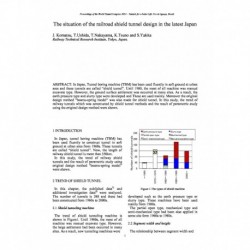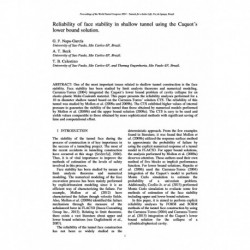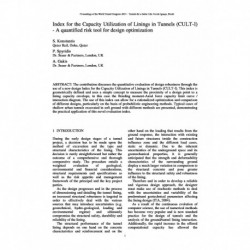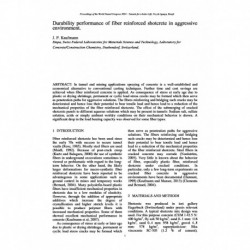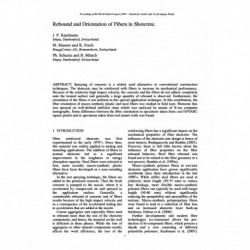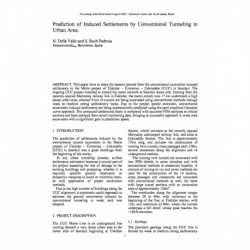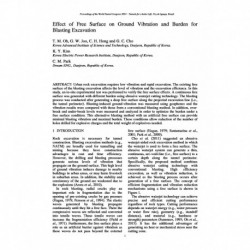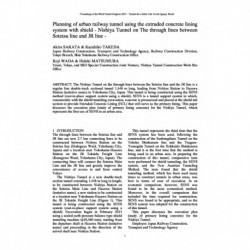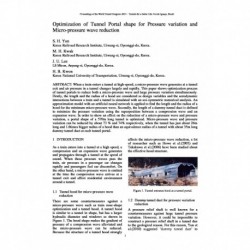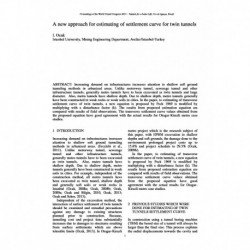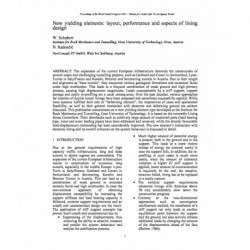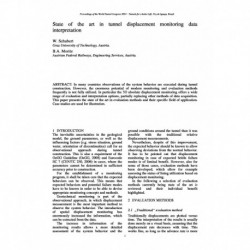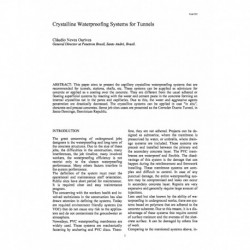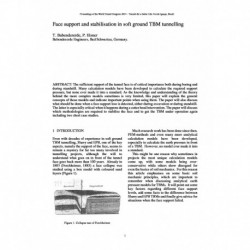No document
Search & filter
Search for a publication
Search & filter
World Tunnelling Congress
WTCThere are 1984 documents.
-
The situation of the railroad shield tunnel design in the latest Japan
Abstract: In Japan, Tunnel boring machine (TBM) has been used fluently in soft ground at urban area and these tunnels are called “shield tunnel”. Until 1980, the most of all machine was manual excavate type. However, the ground surface settlement was occurred at many sites. As a result, the earth pressure type and slurry type were developed and These are used mainly. Moreover the original design method...
0,00 € -
Reliability of face stability in shallow tunnel using the Caquot´s lower bound solution
Abstract: One of the most important issues related to shallow tunnel construction is the face stability. Face stability has been studied by limit analysis theorems and numerical modeling. Carranza-Torr integrated the Caquot´s lower bound problem of cavity collapse for an elastic-plastic Mohr-Coulomb material. This paper presents the reliability analyses performed for a 10 m diameter shallow tunnel based...
0,00 € -
Index for the Capacity Utilization of Linings in Tunnels (CULT-I) - A quantified risk tool for design optimization
Abstract: The contribution discusses the quantitative evaluation of design robustness through the use of a new design Index for the Capacity Utilization of Linings in Tunnels (CULT-I). This index is geometrically defined and uses a simple concept to measure the proximity of a design point to a lining capacity envelope, in this case the Bending moment-Axial force capacity limit...
0,00 € -
Durability performance of fiber reinforced shotcrete in aggressive environment
Abstract: In tunnel and mining applications spraying of concrete is a well-established and economical alternative to conventional casting techniques. Further time and cost savings are achieved when fiber reinforced concrete is applied. As consequence of stress at early age due to plastic or drying shrinkage, permanent or cyclic load stress cracks may be formed which then serve as penetration paths for...
0,00 € -
Adoption of shear keys to provide stability to TBM tunnels segmental lining during cross passages construction: The...
Abstract: Within the 10m diameter, 3.5km long Aked tunnel project, part of the Jerusalem-Tel Aviv Rapid Railway, construction of 14 cross passages between the tubes is being executed. Each one implies partially demolishing two rings, on each tube. To transfer the axial forces acting on the opened rings to the adjacent ones and thus provide stability to the lining, reinforced concrete keys installed on...
0,00 € -
Rebound and Orientation of Fibers in Shotcrete
Abstract: Spraying of concrete is a widely used alternative to conventional construction techniques. The shotcrete may be reinforced with fibers to increase its mechanical performance. Because of the relatively high impact velocity, the concrete and the fibers do not adhere completely onto the treated surface and generally a large quantity of rebound is observed. Furthermore, the orientation of the...
0,00 € -
Prediction of Induced Settlements by Conventional Tunneling in Urban Area
Abstract: This paper aims to share the lessons learned from the conventional excavation induced settlements in the Metro project of Üsküdar – Ümraniye – Çekmeköy (UUC) in Istanbul. The ongoing UUC project intended to extend the metro network at Istanbul Asian side. Starting from the recently opened Marmaray railway link in Üsküdar, the metro stretch runs 17 km underneath a high dense urban area, whereof...
0,00 € -
Effect of Free Surface on Ground Vibration and Burden for Blasting Excavation
Abstract: Urban rock excavation requires low vibration and rapid excavation. The existing free surface of the blasting excavation affects the level of vibration and the excavation efficiency. In this study, an in-situ experimental test was performed to verify the free surface effects. A continuous free surface was generated with different burden using abrasive waterjet cutting technology. The blasting...
0,00 € -
Estimation of Rock Mass Rating (RMR) for TBM using Electrical Resistivity
Abstract: Tunnel excavation using TBMs has many advantages but the TBM method also has some limitations that generate construction delays and increased costs when the TBM runs into problematic sections of ground. Thus, it is important to keep the TBM system safe in the case of unexpected tunnel-ahead ground conditions. To achieve this, the tunnel-ahead prediction system on the TBM needs to reduce the...
0,00 € -
Planning of urban railway tunnel using the extruded concrete lining system with shield - Nishiya Tunnel on The...
Abstract: The Nishiya Tunnel on the through lines between the Sotetsu line and the JR line is a regular line double-track sectional tunnel 1,446 m long, leading from Nishiya Station to Hazawa Station (tentative name) in Yokohama City, Japan. This tunnel is being constructed using the SENS method (cast-in-place support system using a shield). SENS is a tunnel support system in which, concurrently with the...
0,00 € -
Optimization of Tunnel Portal shape for Pressure variation and Micro-pressure wave reduction
Abstract: When a train enters a tunnel at high-speed, a micro-pressure wave generates at a tunnel exit and air pressure in a tunnel changes largely and rapidly. This paper shows optimization process of tunnel portals to reduce both a micro-pressure wave and large pressure variation simultaneously. Firstly, the length and the radius of a hood are considered as design variables and the aerodynamic...
0,00 € -
A new approach for estimating of settlement curve for twin tunnels
Abstract: Increasing demand on infrastructures increases attention to shallow soft ground tunneling methods in urbanized areas. Unlike motorway tunnel, sewerage tunnel and other infrastructure tunnels, generally metro tunnels have to been excavated as twin tunnels and large diameter. Also, metro tunnels have shallow depth. Due to shallow depth, metro tunnels generally have been constructed in weak rocks...
0,00 € -
New yielding elements: layout, performance and aspects of lining design
Abstract: The expansion of the current European infrastructure demands the construction of several major and challenging tunnelling projects, such as Gotthard and Ceneri in Switzerland, LyonTurino in Italy/France and Koralm, Brenner and Semmering tunnels in Austria. Due to their length and alignment as “base tunnels”, they encounter various geological formations and tectonical faults under high...
0,00 € -
State of the art in tunnel displacement monitoring data interpretation
Abstract: In many countries observations of the system behavior are executed during tunnel construction. However, the enormous potential of modern monitoring and evaluation methods frequently is not fully utilized. In particular the 3D absolute displacement monitoring offers a wide range of evaluation and interpretation options, partially replacing other methods of data acquisition. This paper presents...
0,00 € -
Crystalline Waterproofing Systems for Tunnels
Abstract: This paper aims to present the capillary crystalline waterproofing systems that are recommended for tunnels, stations, shafts, etc. These systems can be supplied as admixture for concrete or applied as a coating over the concrete. They are different from the usual adhered or floating superficial systems by reacting with the water and cement paste in the...
0,00 € -
Face support and stabilisation in soft ground TBM tunnelling
Abstract: The sufficient support of the tunnel face is of critical importance both during boring and during standstill. Many calculation models have been developed to calculate the required support pressure, but none ever made it into a standard. As the knowledge and understanding of the theory behind the more complex models sometimes is very limited, this paper will explain the general concepts of those...
0,00 €

